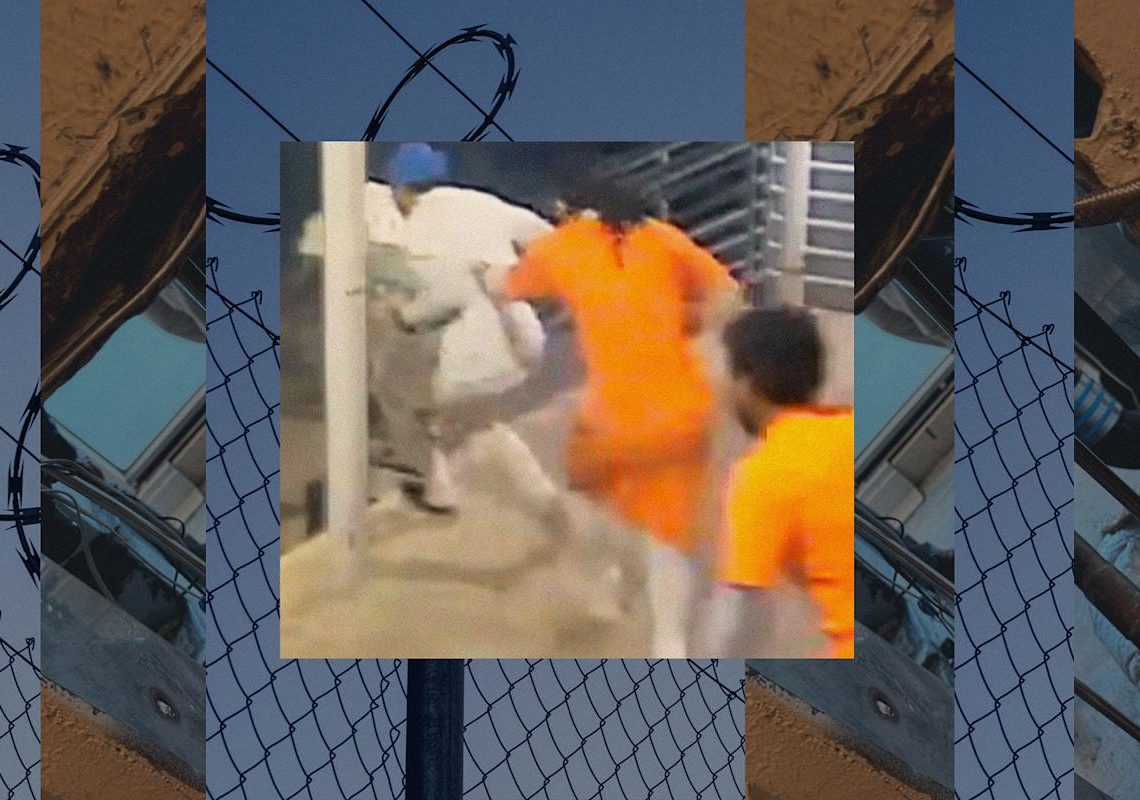The path to freedom began behind a toilet.
After midnight on May 16, inmates at the New Orleans city jail forced open the door of a first-floor cell and crammed inside. At the back, inmates had wrenched a metal bathroom fixture from the wall, exposing a narrow hole where steel bars were sawed off. On the other side was a walkway leading to a loading dock.
The timing was perfect. A jail worker had cut off water to the cell, which allowed the inmates to dislodge the toilet without a telltale flood. There was no deputy patrolling the housing area as there should have been, and a civilian employee whose job was to monitor inmates’ movements had reportedly stepped away for food.
The group assembled in Cell 6 included men who had been held in the Orleans Justice Center for months or years, many of them accused of terrible crimes. One had been convicted in October of killing two people during a 2018 Mardi Gras celebration and was waiting for a likely sentence of life in prison. Two others were awaiting trial on murder charges, another two on attempted murder. A couple of them had previously escaped other lockups.
Now, they were pulling off one of the biggest jailbreaks in Louisiana history, an audacious feat that exploited long-documented failures in the local criminal justice system, including the jail’s inability to properly supervise high-risk inmates. The escape spread anxiety through one of America’s most beloved tourist cities, opening new wounds for victims’ relatives and forcing some into hiding. And it prompted finger-pointing among a Republican governor and local Democratic officials, with much of the heat falling on Orleans Parish Sheriff Susan Hutson, who was elected in 2021 as a progressive reformer but has been criticized for falling short on federally mandated improvements at the jail, including regular security checks.
While the investigation continues, it’s already clear that no one was able to stop the 10 inmates in Cell 6.
The men, ranging in age from 19 to 42, some wearing orange jail uniforms and others in long, white pants and T-shirts, each shimmied through the hole, some pausing to leave taunting messages on the wall. “To easy LOL,” one wrote.
They leapt off the loading dock and made it to a barbed-wire fence, which they scaled with blankets. Then they dashed across an interstate and slipped into the night.
It was about 1:30 a.m. Another seven hours passed before the regular morning head count revealed that the 10 men were missing from Pod 1-D.
By then, they were long gone.
Dawn Cook, a truck driver, was at the wheel of her rig that Friday morning when she got a call from someone at the Orleans Parish District Attorney’s Office telling her Corey Boyd, the man accused of killing her son last year, had broken out of jail.
“He said there’d been an escape,” Cook, 71, recalled. “He didn’t have any details.”
Around the same time, she also got an automated text from a jail messaging system notifying her that Boyd, who was charged with murder, was no longer in custody. If she needed help, it said, call 911.
The news made her more mad than scared.
On April 29, 2024, her son, “Mister” Brandon Fees, was on a porch in the Marigny neighborhood with his girlfriend when they saw a group of people breaking into cars, according to police. Fees, 38, confronted them. They argued, and one of the suspects shot Fees. Boyd then struck Fees with a car, authorities said.
Boyd, 19, who pleaded not guilty, had been in jail for nearly a year before he escaped, and the case was nowhere near going to trial. The killing was caught on surveillance footage, but it took four months for Boyd to be indicted, and since then the case has been slowed by postponements and arguments over the sharing of evidence.
The holdups infuriated her. “I’ve been angry for a year now,” Cook said. “There’s a lot more to this than this escape. This is just too much.”
Delays in criminal cases are a chronic problem in New Orleans — and many other areas of the country — due in large part to backlogs created when the pandemic shut down courts. The difficulties in New Orleans go even deeper. The jail has been under federal scrutiny for overcrowding, understaffing, defective technology and malfunctioning doors; a court-appointed monitor cited the jail last year for failing to separate inmates who were violent or at risk of escape and for leaving housing units unsupervised for hours at a time.
Hutson responded that the jail had improved in some areas, including training, and said she had about half of the staff members she would need to run the jail optimally.
At last count, more than half the 1,400 or so inmates at the Orleans Justice Center were charged with a violent crime, more than 200 of them charged with a homicide.
At 10:30 a.m. on May 16, after authorities knew for sure who was missing and had talked to their alleged victims, officials released word of the jailbreak to the public.
By that point, federal, state and local law enforcement had launched an enormous manhunt, tapping into the city’s network of cameras equipped with facial recognition software.
The escapees had scattered. A surveillance camera spotted Kendell Myles, 20 — charged in a carjacking that left a man seriously wounded — walking in the French Quarter just before 10 a.m. in a dark hoodie and jeans, according to local NBC affiliate WDSU. Police later found him hiding under a car in a hotel parking garage and arrested him after a short chase, officials said.
Robert Moody, 21, who is facing battery, weapons and drug charges, fled south, making it about 2 miles before authorities captured him with help from a Crimestoppers tip. Two more inmates were later caught farther afield, 8 to 10 miles northeast of the jail.
Then, on Tuesday, Cook got a call from the district attorney’s office telling her that Boyd, the man accused of killing her son, had been captured. She had mixed feelings: happy he was back in custody, but not much closer to justice.
“It’s going to take so long for them to do anything,” Cook said.
By the end of the week, half of the inmates remained at large.
They included the Mardi Gras killer, Derrick Groves, convicted of opening fire on a 2018 Fat Tuesday party, killing Jamar Robinson, 26, and Byron Jackson, 21. Groves and a co-defendant were first found guilty in 2019, but a new law requiring unanimous jury verdicts forced a 2023 retrial, which collapsed when a juror broke court rules by reading news accounts of the case. A second trial that year ended with a deadlocked jury. Finally, in October 2024, a new jury found them guilty.
Groves’ escape galled Robinson’s relatives.
The family said in a statement that they heard about it from neighbors at 9 a.m. on May 16, before anyone in law enforcement reached out to them. “This breakdown in communication has only deepened our grief and added to the pain we are already enduring,” the family said.
As a precaution, the family temporarily left the city. The relatives accused Hutson, the sheriff, and her jail staff of allowing the escape to happen. “We say ‘allowed’ because these inmates were essentially handed a ‘Get Out of Jail Free’ card, as if this were a game,” the family said.
Prosecutors who tried Groves also left town with their families over the weekend, Orleans District Attorney Jason Williams said.
“Any family member who is scared or frustrated, they have every right to be because this should not have happened,” Williams said at a Monday news conference. “And if it happened at 1 a.m. they should have been notified at 1:30, because they were in harm’s way.”
As the search wore on, Louisiana Gov. Jeff Landry demanded an investigation by the state attorney general and answers on why some of the escapees’ criminal cases had dragged on for more than a year. He signed an executive order to track cases in Orleans and other “high crime areas,” saying some of the escapees had been kept in the jail for far too long.
“Had they gone to trial, had they been convicted, had they been sentenced, they would most likely not be in Orleans Parish jail, but in the custody of one of the state penitentiaries,” Landry, a Republican, said at a news conference.
Williams, who has said the delays aren’t the fault of the district attorney’s office, did not immediately respond to a request for comment.
The escape itself raised grave questions about jail operations. Among them: How were the inmates able to leave their cells in the middle of the night, force open the door to Cell 6, tear out the bathroom fixture and cut steel bars — and escape through the loading dock under the watch of security cameras — without anyone raising an alarm?
Jail protocols under the federal monitor require a deputy on each housing pod around the clock and a supervisor to perform regular checks, said Rafael C. Goyeneche III, president of the Metropolitan Crime Commission, a private organization that researches the New Orleans-area criminal justice system.
“That means someone should have gone onto that pod, looked in every cell and seen if everyone who was supposed to be in the cells were there,” Goyeneche said. “Obviously that didn’t happen.”
Goyeneche said the jail appears to have missed several opportunities — mandated security rounds, camera surveillance, door-lock monitoring, Friday-morning breakfast service — to notice the escape.
These questions fall to Hutson, a lawyer and former police monitor in Los Angeles and New Orleans who did not have experience as a jailer before she became the first Black female sheriff in Louisiana. Since the escape, she has faced criticism from Landry and local officials in her own party, including Williams and members of the city council.
Hutson, who temporarily suspended her re-election campaign this week and did not respond to a request for comment, has admitted to “procedural failures and missed notifications” and said that the escapees had help from her staff.
She said she suspended three employees without pay, and one civilian worker was arrested on charges he cut water from the cell’s pipes prior to the breakout. The worker, Sterling Williams, told investigators that one of the escapees, Antoine Massey, threatened to shank him if he did not turn the water off, court papers say. But Williams’ lawyer gave a different story, saying his client was asked by a deputy to help fix a clogged toilet in the cell — and was not part of any plan to help the inmates.
And on Friday, authorities arrested a current inmate, Trevon D. Williams, on charges related to the escape. It is not clear what role he allegedly played.
The men also had help after they broke out, according to police. Two women have been charged with giving two fugitives rides around New Orleans. Another allegedly got Boyd food while he was holed up in a house. A fourth gave escapee Jermaine Donald, who is charged with aggravated battery and remains on the run, money through Cash App, police said. And a fifth person was arrested Friday, accused of aiding the escapees.
As the New Orleans manhunt continued, a new one began about 70 miles north. Tra’Von Johnson, charged with murder in a deadly home invasion, escaped the Tangipahoa Parish Jail on Thursday afternoon after another inmate boosted him over a fence, authorities said.
The local sheriff’s office said it didn’t discover the breakout until five hours later, when someone called asking if the man was still in custody. This was the second time Johnson, 22, has escaped the jail in the past year.
This article was originally published on NBCNews.com
The post How a mass escape exposed a New Orleans jail’s security failures appeared first on NBC News.



